Bolivia conjures up images of rainforests, amazing animals, and mysterious ecosystems. It’s a diversity hotspot and contains some of the world’s most amazing flora and fauna, so of course its floral emblem was always going to be spectacular! Let’s discover the national flower of Bolivia: Cantua buxifolia. It’s quite an astonishing plant.
But wait.
Bolivia actually has two national flowers! The other is stunning Heliconia rostrata – the patuju.
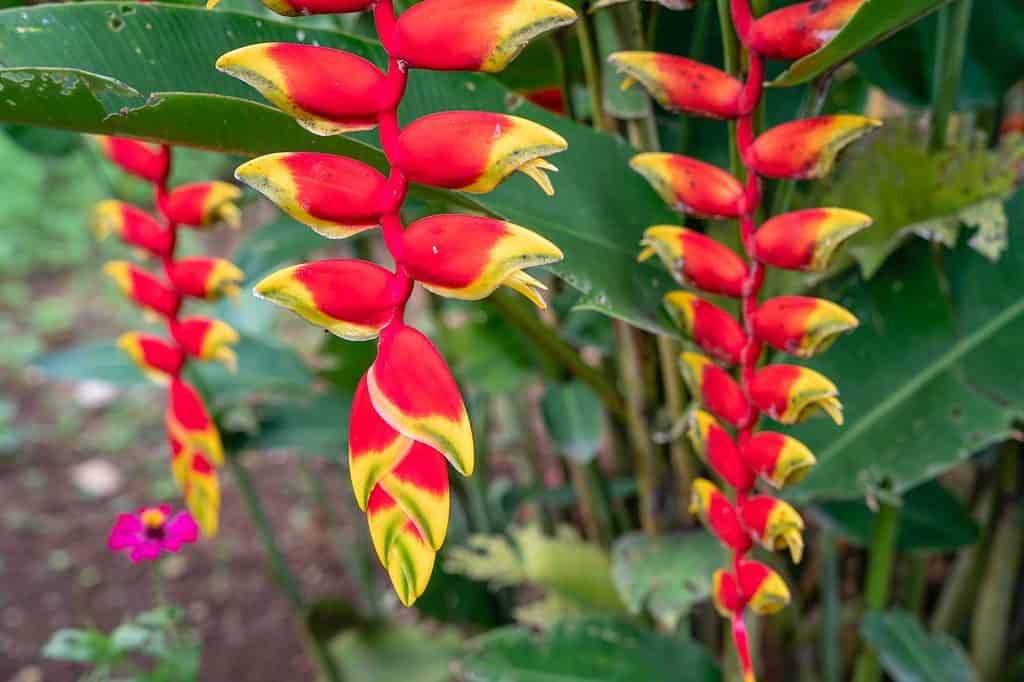
©Michaelnero/Shutterstock.com
What is the National Flower of Bolivia?
Or to put it a better way, discover the national flowers of Bolivia: cantua buxifolia and heliconia rostrata!
Bolivia’s national flowers are the cantua and the patujú. Cantua is botanically called Cantua Buxifolia, which means “flor sagrada del Inca” or sacred flower of the Inca, and buxifolia which is Latin for leaves like box (buxus).
Patuju is Heliconia rostrata and otherwise known as hanging lobster claw or false bird of paradise.
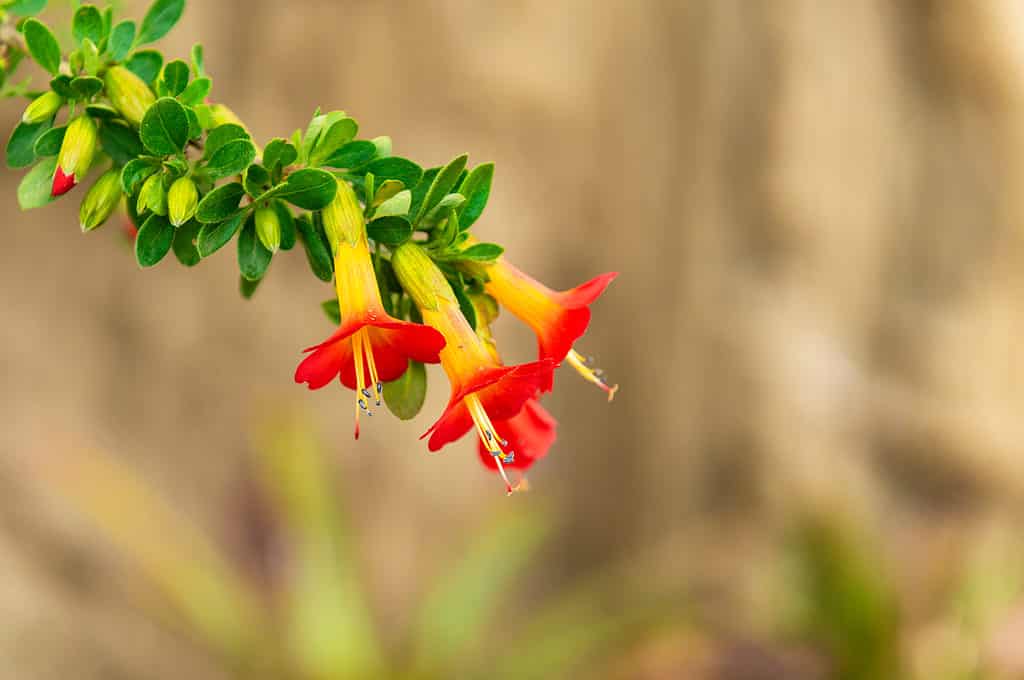
©SL-Photography/Shutterstock.com
A Short History of Bolivia
Let’s take a minute to discover Bolivia, because it will give us insight into why these two gloriously bright flowers were chosen as its national flowers.
The Plurinational State of Bolivia is situated in western central South America. It’s bordered by Argentina, Chili, Peru, Paraguay, and Brazil with no coast line. Bolivia doesn’t have a coast now (that landmass was seized by Chili in 1879), but it has stunning ecosystems. From tropical lowlands to the Andean mountains and the Amazon basin, Bolivia is filled with amazing flora and fauna.
12 million people live in multi-ethnic Bolivia and until 2009 Spanish was their official national language. In 2009 a new national constitution declared every language spoken in Bolivia was an official language, including indigenous Quechua and Aymara. This means Bolivia has almost 30 official languages!
Bolivia’s past is tumultuous and complicated, but here is a very brief outline.
The Andes area of Bolivia was part of the Incan empire and the rest was inhabited by indigenous tribes, but Spanish conquistadors invaded in the 1500s and took control. A good deal of the Spanish empire was funded with silver extracted from Bolivian mines.
Bolivia wanted independence in 1809 and a 16-year war followed. Eventually, a republic was instated and named after Simon Bolivar, a Venezuelan leader during the wars of independence. Bolivar = Bolivia.
But peace didn’t last. In 1971 a coup d’etat installed a military dictatorship in place of its socialist government. Many protesting citizens were tortured and killed under this regime.
Today, Bolivia has a democratically elected government and is viewed as a developing country.
Why is Cantua Buxifolia Bolivia’s National Flower?
Cantua buxifolia and heliconia rostrata flowers are both green, red and yellow, the same colors as the Bolivian flag.
But it doesn’t stop there.
We know that Bolivia is a multi-ethnic country, (its official name is The Plurinational State of Bolivia) and recent legislation has strengthened the rights of indigenous people. Bolivia’s two national flowers represent this multi-ethnic country.
- Cantua buxifolia is native to the Andes and represents western Bolivia
- Heliconia rostrata is native to the Amazonian tropics and represents eastern Bolivia.
Together, Bolivia’s two national flowers represent unity in Bolivia’s different cultures. From the mountainous Andes to the Amazon rainforest, all of Bolivia is united despite its ethnic, cultural, and historical differences.
Cantua buxifolia was the first national flower of Bolivia, but in April 1990 the government decreed the patuju should join it in order to represent all of Bolivia.
The supreme decree states that anytime they are drawn, they must reach toward one another. The cantua should lean right and the patuju should lean left in order to symbolize the union of Bolivia.
Does Bolivia Really Have Two Capital Cities?
No, Bolivia doesn’t have two capital cities. The official capital city is Sucre.
Sucre is it’s constitutional capital that houses the government’s judicial affairs, but La Paz houses the executive and legislative branches.
The two cities are the subject of much violent history.
When Bolivia won its independence in 1825 Sucre was named its official capital city. Its name refers to the revolutionary leader Antonio Jose de Sucre. It was chosen due to its closeness to the silver mines that held most of Bolivia’s wealth.
However, over time the tin mines near La Paz became an even greater source of wealth. After a revolution in 1899, two governmental parties reached a compromise. Sucre would be the judicial seat of government, and La Paz the administrative and legislative seat.
So although Sucre is the official capital city of Bolivia, many believe La Paz is.
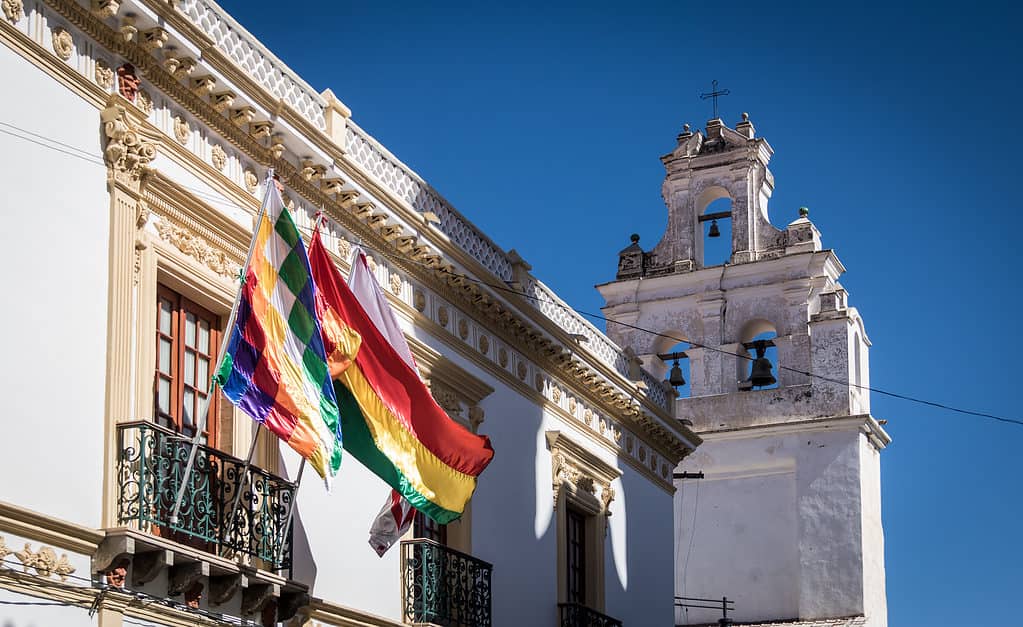
©Diego Grandi/Shutterstock.com
All About Cantua buxifolia: Bolivia’s National Flower

©Jim Fannin/Shutterstock.com
Cantua is a genus of 12 flowering trees and shrubs. They sit in the phlox family and are native to the Andes mountains of Bolivia, Peru, and Ecuador. These glorious flowers grow in mountainous valleys with high temperatures and absent chill.
All cantua species have fragile, long tubular flowers in vivid red, white, yellow, orange and multi-toned colors. The multi-colored cantua cantua buxifolia tricolor is one of Bolivia’s national flowers.
Cantua plants have a historical legend attached to them:
Two kings ruled the Bolivian Altiplano, but fought and were both killed. Before they passed away, the kings made their sons swear to avenge them.
Even though they had no wish to fight, the sons carried out their fathers’ order and mortally wounded each other. But these sons had more sense than their fathers did, and forgave each other before they died.
Pachamama, the fertility goddess, then punished the fathers for condemning their sons to death by commanding their stars to fall. The stars became the snowy Bolivian mountains Illimani and Illampu and their melting snow that fertilizes the rich valleys are said to be their tears of regret.
Cantua buxifolia flowers are red and yellow, the colors of the two kings, and green, which symbolizes hope. It’s another unity in diversity emblem!
Cantua plants reach 10 feet tall and love full sun with regular drenchings of water. Their arching stems are covered in tiny evergreen oval leaves and flowers appear along the stems’ length.
Hummingbirds love cantua nectar because they can easily access it via their tubular blooms. Hummingbirds are cantuas’ main pollinator.
All about Heliconia rostrata: Bolivia’s National Flower
Its “hanging lobster claw” common name really gives it away! Patuju has large green, yellow and red flowers that look like, you’ve got it, lobster claws.
It’s a perennial plant related to the bird of paradise plant and it’s native to Bolivia, Peru, El Salvador, Costa Rica and Ecuador.
It’s an unusual species of heliconia because instead of the traditional upright flowers of its genus, it has downward-facing flowers. This makes it much easier for a hummingbird to extract its nectar and insects to drink trapped water.
Patuju primarily grows wild in the Amazon rainforest and reaches six feet tall. It’s grown in Santa Cruz city as an urban greening plant and graces many urban gardens. It’s also the subject of medical research. Scientists are uncovering its ability to treat jaundice, intestinal pain, and hypertension.
It too has tricolor blooms in red, green, and yellow that matches the Bolivian flag.
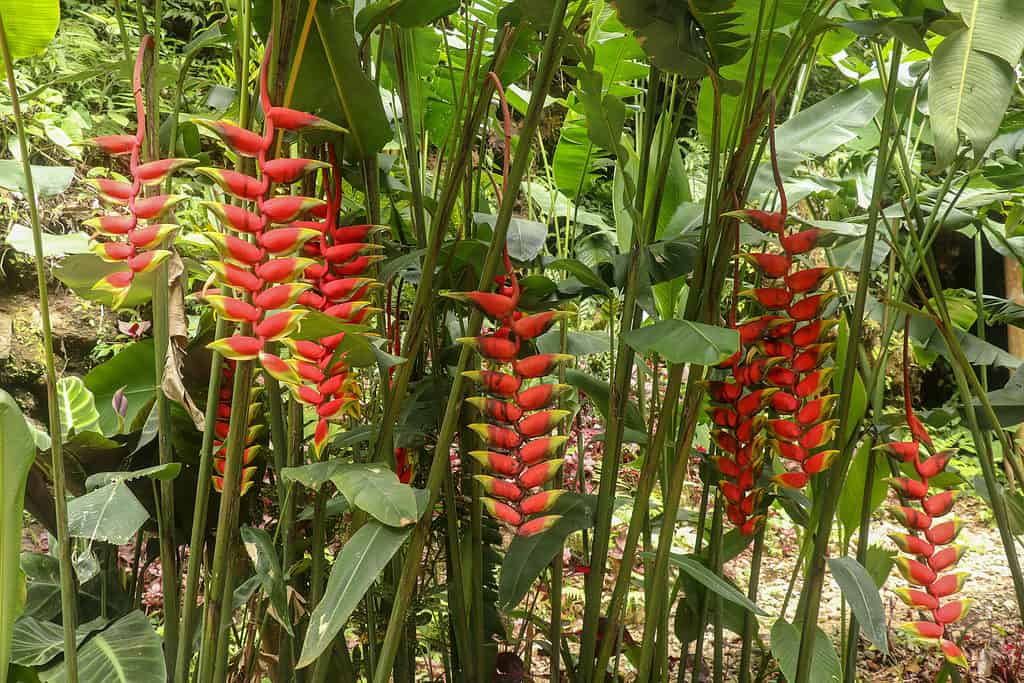
©Sanatana/Shutterstock.com
What are Bolivia’s National Emblems?
If we want to discover the national flowers of Bolivia, Cantua buxifolia and Heliconia rostrata , then it’s only natural we should find out about Bolivia’s other national emblems too!
Bolivian Flags
As well as two national flowers, Bolivia has two flags. The eldest is red, yellow, and green in three horizontal stripes with the Bolivian coat of arms in the center stripe.
The second flag of Bolivia is the whipala, a checkered flag of many colors. It was introduced in 2009 by President Evo Morales, the first indigenous Bolivian president. Rather than the Andes, Quechua and Aymara-centric flag of old, he proposed a flag that represented all the Bolivian cultures (there are at least 36!)

©Jim Barber/Shutterstock.com
Bolivian national animal
Bolivia’s national animal is the llama (pronounced yama in Bolivian). Bolivians from the Andes have used llamas for millennia in much the same way the western world has used donkeys and horses as pack animals.
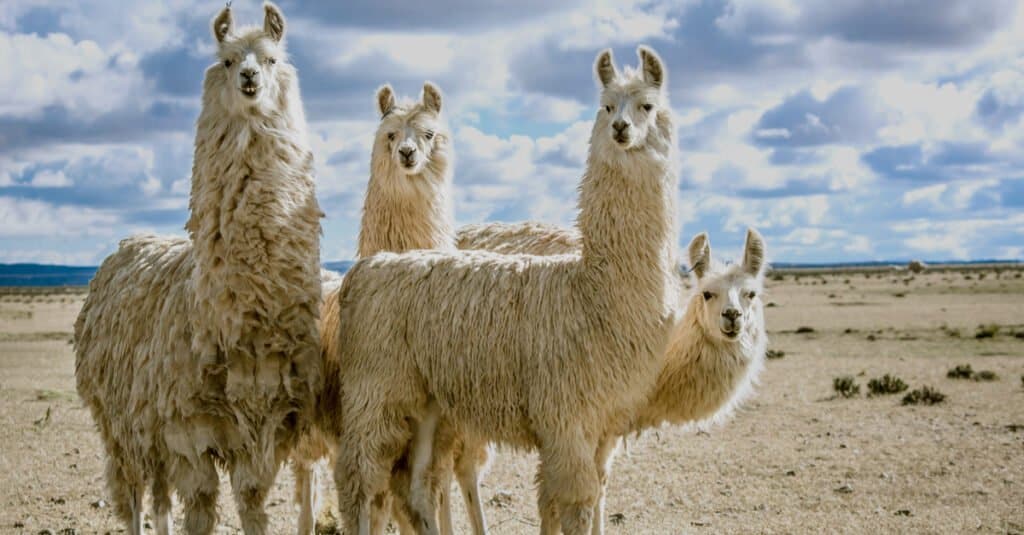
©Noe Besso/Shutterstock.com
Bolivian national bird
The national bird is the native Andean condor (Vulture gryphus). It’s part of the vulture family with a 10 feet wingspan! Its wingspan and heavy weight combine to make it the largest flying bird in the world.
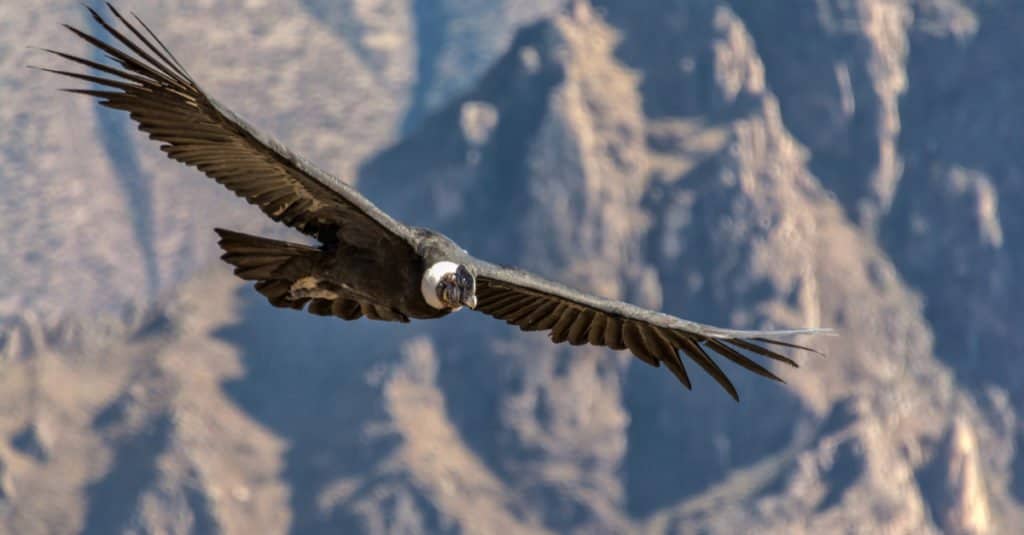
©Gus Martinie/Shutterstock.com
Bolivian national motto
The national motto is ‘We’d rather die than live as slaves” (Morir antes que esclavos vivir). It’s part of the Bolivian national anthem and refers to the violent wars of independence.
Bolivian national tree
Bolivia doesn’t have an official national tree yet, but the eldest Bolivian flag depicts a breadfruit tree. Who knows, in the future, there may be two national trees of Bolivia.
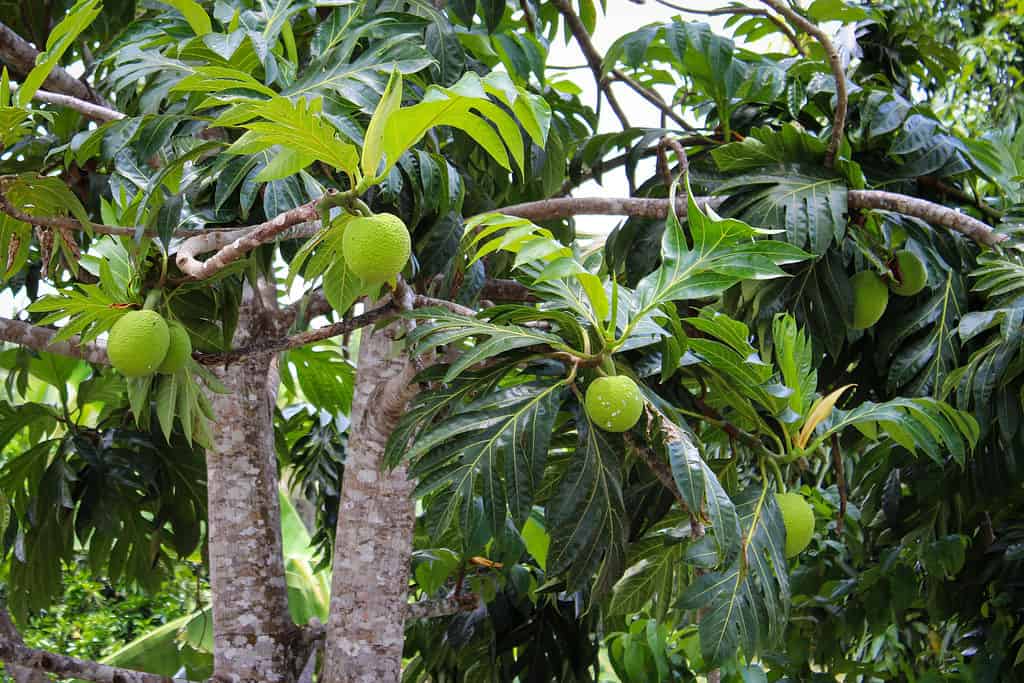
©David Fadul/Shutterstock.com
Up Next
The post Discover The National Flower of Bolivia: Cantua Buxifolia appeared first on AZ Animals.
from Animal News, Facts, Rankings, and More! - AZ Animals https://ift.tt/edqzWjZ